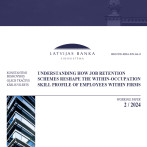Labour market improvement is slow, but it should not be speeded up artificially
Actual unemployment has stabilized since mid-2013 somewhat above 11% (11.9% in the first quarter of 2014). In all likelihoods, that is close to the current natural rate of unemployment, i.e. unemployment related to low and predictable inflation.
Some may feel that if the rise in consumer prices is low, then unemployment cyclical component may be high, therefore unemployment can be reduced at a faster pace, with the help of "step-on-it" policies.
However, the inflation dynamic, first of all, tends to reflect the development of economy with a delay; second, the part of inflation characterizing economic development, core inflation, is slowly growing and is higher than total inflation. Thus, for the drop in unemployment to be sustainable and not to create a pressure on inflation, it has to be based not on stimulating demand but on reducing the lack of balance between the supply and demand of labour – in the form of developing skills, professions, branches and regions; reducing the tax burden on labour income etc. Since this process cannot take place quickly, we are not likely to see a rapid drop in unemployment as was observed from mid-2010 to mid-2013.
A slow rise in employment (0.2% in the first quarter of 2014. year-on-year) could continue – mostly on account of rising participation rate. First, in the next few years, the age structure of the population will change to the advantage of cohorts (age groups) with higher levels of economic activity. E.g., young people between 15 and 24 have low economic activity and the proportion of this cohort will continue to contract. The population in the 25-34 age group are characterized by a high level of economic activity and the proportion of this cohort will rise. Second, the percentage of people with higher education will continue to grow and the better the education, the higher the economic activity. Third, the level of economic activity may rise in the 62+ age group due to the gradual raising of the retirement age and a rise in healthy life expectancy.
The rise in employment will, however, be dampened by the drop in population numbers and proportion of the working-age group. The good news is that the drop in total population will become ever slower and the negative balance of migration will continue to approach zero.
Textual error
«… …»




